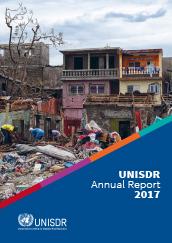
2017 UNISDR Annual Report
By Jeanette Elsworth
GENEVA, 11 June 2018 – The Annual Report of the UN Office for Disaster Risk Reduction, UNISDR, highlights significant progress in the training of member states in monitoring implementation of the Sendai Framework for Disaster Risk Reduction 2015-2030, the global plan for reducing disaster losses.
The report notes that, following adoption of 38 indicators in 2017 for measuring progress against the Sendai Framework’s seven targets, UNISDR worked to develop an online monitoring system, which was piloted during the Global Platform for Disaster Risk Reduction in Cancún, Mexico, in May 2017.
UNISDR formally launched the Sendai Framework Monitor on 1 March 2018. The monitoring system is gathering data to enhance understanding of disaster risk; better enable UN Member States to report on progress in achieving the Sendai Framework’s targets; and enable reporting on common indicators for the SDGs, particularly SDGs 1, eradicating poverty, SDG11, resilient cities, and SDG13, climate action.
The Annual Report shows that 109 Member States had been trained in the use of the Sendai Framework Monitor by the end of 2017 and this work is continuing.
“The year 2017 was full of reminders why the work of disaster risk reduction is so important,” said Mami Mizutori, Special Representative of the Secretary-General for Disaster Risk Reduction, in the foreword, citing a record Atlantic hurricane season in the Caribbean and devastating disasters in Africa and Asia.
Ms. Mizutori also flagged the impacts of smaller, less visible events that happen regularly and often go unreported. “While losses on this scale are very visible, the accumulation of impacts from recurring, small-scale disaster events that do not grab the headlines can be equally corrosive of a community’s resilience to disasters,” she said.
2017 was one of the costliest years for disaster losses ever, heightened by the risk drivers of climate change, poorly planned urbanisation in hazard-prone areas, environmental degradation and rising inequality.